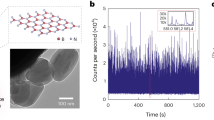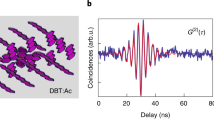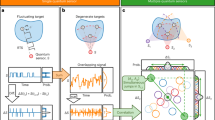Abstract
Solid-state quantum emitters have emerged as a leading quantum memory for quantum networking applications. However, standard optical characterization techniques are neither efficient nor repeatable at scale. Here we introduce and demonstrate spectroscopic techniques that enable large-scale, automated characterization of colour centres. We first demonstrate the ability to track colour centres by registering them to a fabricated machine-readable global coordinate system, enabling a systematic comparison of the same colour centre sites over many experiments. We then implement resonant photoluminescence excitation in a widefield cryogenic microscope to parallelize resonant spectroscopy, achieving two orders of magnitude speed-up over confocal microscopy. Finally, we demonstrate automated chip-scale characterization of colour centres and devices at room temperature, imaging thousands of microscope fields of view. These tools will enable the accelerated identification of useful quantum emitters at chip scale, enabling advances in scaling up colour centre platforms for quantum information applications, materials science and device design and characterization.
This is a preview of subscription content, access via your institution
Access options
Access Nature and 54 other Nature Portfolio journals
Get Nature+, our best-value online-access subscription
$29.99 / 30 days
cancel any time
Subscribe to this journal
Receive 12 print issues and online access
$259.00 per year
only $21.58 per issue
Buy this article
- Purchase on Springer Link
- Instant access to full article PDF
Prices may be subject to local taxes which are calculated during checkout





Similar content being viewed by others
Data availability
The data that support the plots within this paper and other findings of this study are available from the corresponding author upon reasonable request.
Code availability
The code that supports the plots in this paper is available from the corresponding author upon reasonable request.
References
Awschalom, D. et al. Development of quantum interconnects (QuICs) for next-generation information technologies. PRX Quantum 2, 017002 (2021).
Alexeev, Y. et al. Quantum computer systems for scientific discovery. PRX Quantum 2, 017001 (2021).
Sukachev, D. D. et al. Silicon-vacancy spin qubit in diamond: a quantum memory exceeding 10 ms with single-shot state readout. Phys. Rev. Lett. 119, 223602 (2017).
Bar-Gill, N., Pham, L. M., Jarmola, A., Budker, D. & Walsworth, R. L. Solid-state electronic spin coherence time approaching one second. Nat. Commun. 4, 1743 (2013).
Nemoto, K. et al. Photonic quantum networks formed from NV-centers. Sci. Rep. 6, 26284 (2016).
Janitz, E., Bhaskar, M. K. & Childress, L. Cavity quantum electrodynamics with color centers in diamond. Optica 7, 1232–1252 (2020).
Siyushev, P. et al. Monolithic diamond optics for single photon detection. Appl. Phys. Lett. 97, 241902 (2010).
Hadden, J. P. et al. Strongly enhanced photon collection from diamond defect centers under microfabricated integrated solid immersion lenses. Appl. Phys. Lett. 97, 241901 (2010).
Mouradian, S., Wan, N. H., Schröder, T. & Englund, D. Rectangular photonic crystal nanobeam cavities in bulk diamond. Appl. Phys. Lett. 111, 021103 (2017).
Calusine, G., Politi, A. & Awschalom, D. D. Silicon carbide photonic crystal cavities with integrated color centers. Appl. Phys. Lett. 105, 011123 (2014).
Nguyen, C. T. et al. An integrated nanophotonic quantum register based on silicon-vacancy spins in diamond. Phys. Rev. B 100, 165428 (2019).
Rugar, A. E. et al. Quantum photonic interface for tin-vacancy centers in diamond. Phys. Rev. X 11, 031021 (2021).
Bayat, K., Choy, J., Baroughi, M. F., Meesala, S. & Lončar, M. Efficient, uniform, and large area microwave magnetic coupling to NV centers in diamond using double split-ring resonators. Nano Lett. 14, 1208–1213 (2014).
Mouradian, S. L. et al. Scalable integration of long-lived quantum memories into a photonic circuit. Phys. Rev. A 92, 043844 (2015).
Janitz, E. et al. Fabry-Perot microcavity for diamond-based photonics. Phys. Rev. A 92, 043844 (2015).
Gould, M. et al. Large-scale GaP-on-diamond integrated photonics platform for NV center-based quantum information. J. Opt. Soc. Am. B 33, B35–B42 (2016).
Wan, N. H. et al. Large-scale integration of artificial atoms in hybrid photonic circuits. Nature 583, 226–231 (2020).
Ruf, M., Wan, N. H., Choi, H., Englund, D. & Hanson, R. Quantum networks based on color centers in diamond. J. Appl. Phys. 130, 070901 (2021).
Bradley, C. E. et al. A ten-qubit solid-state spin register with quantum memory up to one minute. Phys. Rev. X 9, 031045 (2019).
Stas, P.-J. et al. Robust multi-qubit quantum network node with integrated error detection. Science 378, 557–560 (2022).
Waldherr, G. et al. Quantum error correction in a solid-state hybrid spin register. Nature 506, 204–207 (2014).
Benjamin, S. C., Browne, D. E., Fitzsimons, J. & Morton, J. J. Brokered graph-state quantum computation. New J. Phys. 8, 141 (2006).
Choi, H., Pant, M., Guha, S. & Englund, D. Percolation-based architecture for cluster state creation using photon-mediated entanglement between atomic memories. npj Quantum Inf. 5, 104 (2019).
Hermans, S. L. N. et al. Qubit teleportation between non-neighbouring nodes in a quantum network. Nature 605, 663–668 (2022).
Bhaskar, M. K. et al. Experimental demonstration of memory-enhanced quantum communication. Nature 580, 60–64 (2020).
Pompili, M. et al. Realization of a multinode quantum network of remote solid-state qubits. Science 372, 259–264 (2021).
Lee, Y., Bersin, E., Dahlberg, A., Wehner, S. & Englund, D. A quantum router architecture for high-fidelity entanglement flows in quantum networks. npj Quantum Inf. 8, 75 (2022).
Bersin, E. et al. Individual control and readout of qubits in a sub-diffraction volume. npj Quantum Inf. 5, 38 (2019).
Bassett, L. C., Heremans, F. J., Yale, C. G., Buckley, B. B. & Awschalom, D. D. Electrical tuning of single nitrogen-vacancy center optical transitions enhanced by photoinduced fields. Phys. Rev. Lett. 107, 266403 (2011).
Meesala, S. et al. Strain engineering of the silicon-vacancy center in diamond. Phys. Rev. B 97, 205444 (2018).
Metz, J. & Barrett, S. D. Effect of frequency-mismatched photons in quantum-information processing. Phys. Rev. A 77, 042323 (2008).
Stolk, A. et al. Telecom-band quantum interference of frequency-converted photons from remote detuned NV centers. PRX Quantum 3, 020359 (2022).
Levonian, D. et al. Optical entanglement of distinguishable quantum emitters. Phys. Rev. Lett. 128, 213602 (2022).
Walsh, M. P. Statistical Metrology and Process Control of Quantum Devices. PhD thesis, Massachusetts Institute of Technology (2020).
Chakravarthi, S. et al. Window into NV center kinetics via repeated annealing and spatial tracking of thousands of individual NV centers. Phys. Rev. Mater. 4, 023402 (2020).
Chu, Y. et al. Coherent optical transitions in implanted nitrogen vacancy centers. Nano Lett. 14, 1982–1986 (2014).
Fu, K.-M., Santori, C., Barclay, P. E. & Beausoleil, R. G. Conversion of neutral nitrogen-vacancy centers to negatively charged nitrogen-vacancy centers through selective oxidation. Appl. Phys. Lett. 96, 121907 (2010).
Sangtawesin, S. et al. Origins of diamond surface noise probed by correlating single-spin measurements with surface spectroscopy. Phys. Rev. X 9, 031052 (2019).
Yuan, Z. et al. Charge state dynamics and optically detected electron spin resonance contrast of shallow nitrogen-vacancy centers in diamond. Phys. Rev. Res. 2, 033263 (2020).
Rogers, L. J. et al. All-optical initialization, readout, and coherent preparation of single silicon-vacancy spins in diamond. Phys. Rev. Lett. 113, 263602 (2014).
Christen, I. et al. An integrated photonic engine for programmable atomic control. Preprint at https://arxiv.org/abs/2208.06732 (2022).
Day, A., Dietz, J., Sutula, M., Yeh, M. & Hu, E. L. Laser writing of spin defects in nanophotonic cavities. Nat. Mater. 22, 696–702 (2023).
Viitaniemi, M. L. K. et al. Coherent spin preparation of indium donor qubits in single ZnO nanowires. Nano Lett. 22, 2134–2139 (2022).
Higginbottom, D. B. et al. Optical observation of single spins in silicon. Nature 607, 266–270 (2022).
Lukin, D. M. et al. 4H-silicon-carbide-on-insulator for integrated quantum and nonlinear photonics. Nat. Photon. 14, 330–334 (2020).
Dietz, J. R., Jiang, B., Day, A. M., Bhave, S. A. & Hu, E. L. Spin-acoustic control of silicon vacancies in 4H silicon carbide. Preprint at https://arxiv.org/abs/2205.15488 (2022).
Babin, C. et al. Fabrication and nanophotonic waveguide integration of silicon carbide colour centres with preserved spin-optical coherence. Nat. Mater. 21, 67–73 (2022).
Hu, X. et al. Photoluminescence of InAs/GaAs quantum dots under direct two-photon excitation. Sci. Rep. 10, 10930 (2020).
Trusheim, M. E. et al. Transform-limited photons from a coherent tin-vacancy spin in diamond. Phys. Rev. Lett. 124, 023602 (2020).
Davidsson, J. et al. Exhaustive characterization of modified Si vacancies in 4H-SiC. Nanophotonics 11, 4565–4580 (2022).
Aharonovich, I., Englund, D. & Toth, M. Solid-state single-photon emitters. Nat. Photon. 10, 631–641 (2016).
Schröder, T. et al. Scalable focused ion beam creation of nearly lifetime-limited single quantum emitters in diamond nanostructures. Nat. Commun. 8, 15376 (2017).
Acknowledgements
M.S. and E.B. acknowledge support from the NASA Space Technology Graduate Research Fellowship Program. I.C. acknowledges support from the National Defense Science and Engineering Graduate Fellowship Program, the National Science Foundation (NSF) EFRI ACQUIRE program EFMA-1641064 and NSF award DMR-1747426. M.S. and M.P.W. acknowledge partial support from the NSF Center for Integrated Quantum Materials (CIQM), DMR-1231319. K.C.C. acknowledges support from the NSF RAISE-TAQS CHE-1839155 and the MITRE Corporation Moonshot program. D.R.E. acknowledges partial support from the NSF Center for Quantum Networks (CQN), EEC-1941583. Construction of the robotic cryogenic microscope was supported in part by the Air Force Office of Scientific Research under award no. FA9550-20-1-0105, supervised by G. Pomrenke. Distribution Statement A. Approved for public release. Distribution is unlimited. Diamond growth is based on work supported by the National Reconnaissance Office (NRO) under Air Force Contract no. FA8702-15-D-0001. Any opinions, findings, conclusions or recommendations expressed in this material are those of the author(s) and do not necessarily reflect the views of the National Reconnaissance Office. The FIB implantation work was performed at the Center for Integrated Nanotechnologies, an Office of Science User Facility operated for the US Department of Energy (DOE) Office of Science. Sandia National Laboratories is a multimission laboratory managed and operated by the National Technology and Engineering Solutions of Sandia, LLC, a wholly owned subsidiary of Honeywell International, Inc., for the US DOE’s National Nuclear Security Administration under contract DE-NA-0003525. The views expressed in the Article do not necessarily represent the views of the US DOE or the United States government. This work made use of the Shared Experimental Facilities supported in part by the MRSEC Program of the NSF under award no. DMR-1419807.
Author information
Authors and Affiliations
Contributions
M.S., I.C., E.B. and M.P.W. conceived and performed the experiments, developed the software and built the optical setups. I.C. developed the software and optical setups for widefield data collection and chip-scale sample screening. M.S. analysed the data and wrote the manuscript with assistance from I.C., E.B., M.P.W. and K.C.C. K.C.C. fabricated the QR codes designed by M.P.W. SiV Sample A was produced by J.M., A.M., S.H., D.B. and P.B.D. SiV Sample B was FIB implanted by M.T. and E.S.B. D.R.E. supervised the project. All authors discussed the results and contributed to the manuscript.
Corresponding author
Ethics declarations
Competing interests
The authors declare no competing interests.
Peer review
Peer review information
Nature Materials thanks the anonymous reviewers for their contribution to the peer review of this work.
Additional information
Publisher’s note Springer Nature remains neutral with regard to jurisdictional claims in published maps and institutional affiliations.
Supplementary information
Supplementary Information
Supplementary Figs. 1–9, Sections 1–10 and Table 1.
Supplementary Video 1
Widefield PLE of silicon-vacancy centres in chemical-vapour-deposited diamond. a–d, Scanning over the A, B, C and D optical transitions of the SiV, in a field of view. As expected, the C transition is the brightest of the four. The frequency of the resonant laser for a given frame is noted in the lower-left part of the panel. Scale bar, 10 μm. Every frame represents approximately half a second of measurement (video displayed at ×10 speed). All the panels are linearly scaled to the same fixed colour limit.
Supplementary Video 2
Chip-scale measurement of a sample with nanofabricated pillars. a, Bright-field images of each field of view, with boxes marking features that are detected as checksum-satisfying QR codes. The green boxes satisfy the majority-vote conditions for the field of view, and are considered correct. The yellow boxes usually result from noise that happens to satisfy the checksum, or from a bit error event that fails in the majority-vote condition. b, Fluorescence measurements with a 737 nm bandpass filter targeting the SiV colour centres. c, Fluorescence measurements with a 640 nm longpass filter, with a lower signal-to-noise ratio. This is probably due to fluorescence from the NV centres or other emitters in the sample, especially in the bulk. Scale bars, 10 μm. Every frame represents approximately 40 s of alignment and 20 s of measurement (video displayed at ×600 speed). Each panel is linearly scaled to the maximum and minimum of each frame, except for b, which is scaled to a fixed colour limit.
Supplementary Video 3
Chip-scale measurement of a sample with deleterious noise. a, Bright-field images with the same box colour coding as Supplementary Video 2. This video demonstrates the robustness of our convolutional QR detection algorithm: we are able to detect QRs even through regions coated with stochastic particulates that pose a challenge for non-convolutional approaches. Every frame represents approximately 20 s of alignment and 20 s of measurement (video displayed at ×400 speed). This panel is linearly scaled to the maximum and minimum of each frame.
Supplementary Video 4
Chip-scale measurement of a sample with complex fabricated structures. a, Bright-field images with the same box colour coding as Supplementary Video 2. Despite the bright and varying nature of these fabricated structures, we are still able to conduct full-chip measurements. b, Fluorescence measurements at each field of view. The bright spots on the waveguides are attributed to either colour centres, largely tin vacancy in this case, or points where waveguide-coupled fluorescence is scattered upwards. Scale bars, 10 μm. Every frame represents approximately 20 s of alignment and 10 s of measurement (video displayed at ×300 speed). Here a is linearly scaled to the maximum and minimum of each frame and b is scaled to a fixed colour limit.
Supplementary Video 5
Chip-scale measurement of sample B—a sample co-implanted with silicon, germanium and tin. a, Bright-field images with the same box colour coding as Supplementary Video 2. b, Fluorescence images with a 640 nm longpass filter. c, False-colour images composited from three fluorescent measurements using 737, 620 and 600 nm bandpass filters with ~10 nm bandwidth on the red-, green- and blue-coloured channels. These filters target the ZPLs of silicon-, tin- and germanium-vacancy colour centres, respectively, although germanium appears as cyan due to its phonon sideband overlapping with the filter targeting the ZPL of tin. Scale bars, 10 μm. Every frame represents approximately 30 s of alignment and 25 s of measurement (video displayed at ×550 speed). Here a and b are linearly scaled to the maximum and minimum of each frame and c is shown with a fixed colour range in the log scale to increase the visibility of regions implanted with low dose.
Rights and permissions
Springer Nature or its licensor (e.g. a society or other partner) holds exclusive rights to this article under a publishing agreement with the author(s) or other rightsholder(s); author self-archiving of the accepted manuscript version of this article is solely governed by the terms of such publishing agreement and applicable law.
About this article
Cite this article
Sutula, M., Christen, I., Bersin, E. et al. Large-scale optical characterization of solid-state quantum emitters. Nat. Mater. 22, 1338–1344 (2023). https://doi.org/10.1038/s41563-023-01644-8
Received:
Accepted:
Published:
Issue Date:
DOI: https://doi.org/10.1038/s41563-023-01644-8
This article is cited by
-
Predicting quantum emitter fluctuations with time-series forecasting models
Scientific Reports (2024)



